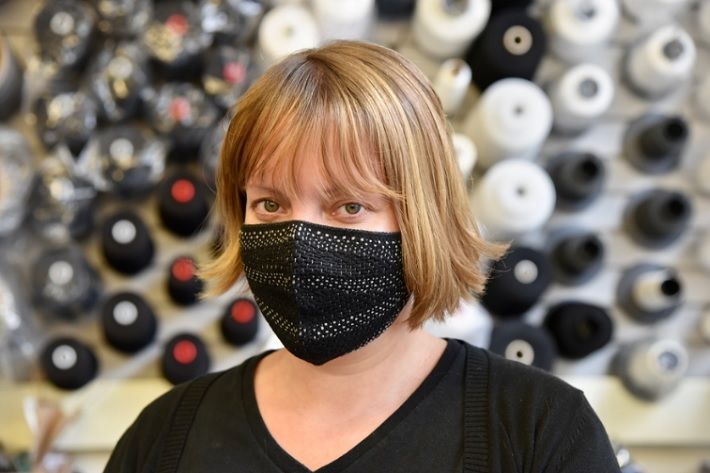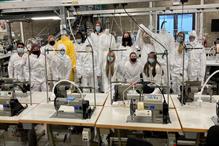
Before coming to MIT in 2017, Tessmer had no formal introduction to textiles. She began working with Skylar Tibbits, associate professor in the department of architecture and founder of the Self-Assembly Lab, where programmable materials — simple materials that can be activated to sense, respond, and transform — are among its research topics. The following year, the lab purchased an industrial flatbed knitting machine, ubiquitous in textile manufacturing around the world, and Tessmer set to work learning how to operate it.
“Lavender was already trying to make textile apparel with a customised fit, so we could quickly transition to making customised masks,” said Tibbits. “But the main challenge with any customisation is that you cannot make each mask unique. It becomes a factory logistics problem. You have to be able to mass-produce these. Customers don’t want to wait weeks or months for their unique mask.”
“Lavender created the knit structure — the architecture — of the mask,” added Tibbits. “The material properties alone don’t lead to the behaviour of precise transformation. It’s basically two- or three-dimensionally knitting structures, and with every single stitch you can change the structure and the materials.”
Tessmer also developed one of the two active fibres (the other was already commercially available) needed to respond to heat so the fabric could be controlled in a predictable way.
“There had to be a clear relationship between how much heat is applied, the method of applying it with the robot, and having a predictable result in the dimensional transformation of the fabric,” explained Tessmer. “That was an iterative process between developing the multi-layered fabric, measuring its dimensional change, and then eventually being able to have the robot apply heat in a repeatable and predictable way.”
Already in the public realm were guidelines for existing ranges of human facial feature measurements. The starting shape of the mask is large enough for almost every face before it’s transformed and customised. From there, Tessmer input dimensions from an individual’s face and the knit masks were activated with a robotic arm outfitted with a heat gun that applies heat in specific patterns to tailor them precisely to the facial measurements.
“The strength of Lavender and Skylar’s work is that it takes advantage of additive manufacturing techniques, which can be spun up for production very quickly,” said Gihan Amarasiriwardena ’11, a ministry of supply co-founder and the company’s president. “Working with the Self-Assembly Lab, we were able to design, test, and develop a mask in five days and have 4,000 masks produced in two weeks for health care workers due to our ability to use 3D computerised knitting. I think this will be a critical asset in being able to divert existing materials toward masks very quickly in the future.”
“The objective was to transform a mask to achieve the perfect fit for anyone’s face, which is a major challenge with masks and other pieces of clothing,” added Tibbits. “No one has really figured out how to do that, other than hiring a tailor or having lots of standard sizes that don’t fit perfectly.”
It is important to note that Tessmer and Tibbits' work was focused on a mask’s fit, and not the properties required for a mask’s material to filter out airborne particles — although a standard filter could be included to enhance its efficacy. The masks are also reusable and washable.
“Our goal was better fibres and a controllable, repeatable process to create a custom-fit mask,” said Tessmer. “We created masks for nine different people to demonstrate how effective the process is.”
Tessmer says the masks were a great case study because they were a sought-after accessory the last few years, and there have been noticeable problems with how masks fit. She would like to apply the process to other types of garments and accessories, such as sweaters and shoes.
“At the end of every project there are always things you find that need to be improved upon,” Tessmer said. “There’s a lot of future fabric development, for example. But I’m happy with the project because it is a working proof-of-concept for my idea, and I’m confident that it works.”
Fibre2Fashion News Desk (RR)

